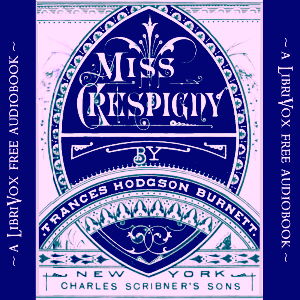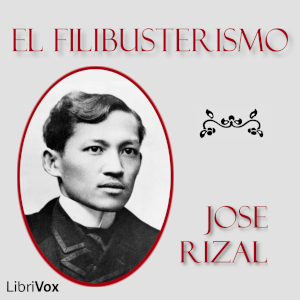This is a less known, but not less beautiful, novel by the author of The Secret Garden, A Little Princess, The Lost Prince, Little Lord Fauntleroy, The Shuttle, and many more. There is something different about miss Lysbeth Crespigny. Raised by three maiden aunts and sheltered from the world, she leaves them for the first time in order to explore the world. Yet she is often misunderstood. The world she discovers is more complicated and confusing then she anticipates. She is only 18 when the book starts. However the choices she has to make have consequences which she learns to navigate and become the strong woman she can be. - Summary by Stav Nisser.
19 episodes
Young naive sailor Billy Budd is impressed into military service with the British navy in the 1790s, framed for conspiracy to mutiny, summarily convicted in a drum-head court martial, and hanged. Billy Budd is the final published work by Herman Melville, discovered in his personal papers three decades after his death. (Summary by ScientificMethodist)
10 episodes

This is a 1924 fantasy novel by Anglo-Irish writer Lord Dunsany, which became public domain in January 2020. It is widely recognized as one of the most acclaimed works in all of fantasy literature. Highly influential upon the fantasy genre as a whole, the novel was particularly formative in the subgenres of "fairytale fantasy" and "high fantasy". And yet, it deals always with the truth: the power of love, the allure of nature, the yearning for contentment, the desire for fame, the quest for immortality, and the lure and the fear of magic. Arthur C. Clarke said this novel helped cement Dunsany as "one of the greatest writers of this century". Receiving numerous accolades, Gahan Wilson called it "likely Dunsany's masterpiece", concluding "it could be the very best fairy story ever written". This reader agrees, describing it as the most sensuous piece of writing she has ever recorded . . . simple, lilting, alluring, suggestive, mesmerizing, invigorating, inspiring, and thoroughly original. (Summary by Wikipedia and Soloist, Michele Fry)
34 episodes
This is the first edition of Hemingway's in our time, published in a very small run in France in 1924. And American edition was released the following year. There are 18 brief short stories---one might say vignettes---that demonstrate the author's early interests and his increasingly iconic literary style. - Summary by KevinS
18 episodes
Die junge Pianistin Erika trifft bei einer Abendgesellschaft auf einen vielversprechenden Geigenvirtuosen. Sofort voneinander angezogen, treffen sie sich immer häufiger, bis er Erika bei einem Wochenendspaziergang seine Liebe gesteht...
In dieser kurzen Novelle lotet Stefan Zweig meisterhaft die (Un-) Tiefen der Liebe aus.
A short novella about the depths and shallows of Love by Austrian novelist Stefan Zweig. (Summary by Availle)
4 episodes
Gaspar Montenegro un personaje de la aristocracia, adinerado cínico y amoral, conoce a una mujer, Rita Quiñones, que está muy enferma y cercana a la muerte con la que mantiene una relación amistosa sin más. Cuando fallece decide adoptar a su hijo, Rafaelín, sin escatimar en su educación. Trini es una antigua novia de Gaspar, éste decide volver a enamorar a Trini y convencerla para casarse y de educar juntos a Rafaelín.
Gaspar Montenegro es un dandy apático a quien Rafaelín saca de esa patológica insensibilidad. Siempre obsesionado con la muerte “La seca” ( Montse González)
18 episodes
The Philippines, still a Spanish colony, are more or less run by the Catholic friars, and with an iron fist.. However, here and there are pockets of insurrection. In the countryside, a group of outlaws takes things in their own hands – including the money of the rich. And the students of Manila petition the government to be taught in Tagalog instead of Spanish.
Follow Basilio, a medical student and his friends as they navigate the difficult climate in Manila, while his fiance struggles with the law in their hometown. Above all this looms the figure of Simoun, a powerful and extremely rich jeweller, who is more than ready to put his immeasurable wealth to use...
El Filibusterismo is the sequel to Noli me Tangere, and cited among the reasons for the execution of the author, who is now regarded national hero of the Philippines. (Summary by Availle)
40 episodes
Ce recueil de 6 nouvelles originales de Prosper Mérimée (1803-1870) nous emmène vers le surnaturel et le domaine du rêve avec sorcières, fantômes et hommes transformés en animaux sauvages. Mérimée maîtrise parfaitement la création du suspense et des dénouements surprenants. Aussi incluse dans cette compilation est la traduction d'une nouvelle de Pouchkine. - Summary by Sonia
20 episodes
Orgullo y prejuicio (en inglés, Pride and Prejudice), publicada por primera vez el 28 de enero de 1813 como una obra anónima, es la más famosa de las novelas de Jane Austen y una de las primeras comedias románticas en la historia de la novela. Su primera frase es, además, una de las más famosas en la literatura inglesa: «Es una verdad mundialmente reconocida que un hombre soltero, poseedor de una gran fortuna, necesita una esposa». Es una novela de desarrollo personal, en la que las dos figuras principales, Elizabeth Bennet y Fitzwilliam Darcy, cada uno a su manera y, no obstante, de forma muy parecida, deben madurar para superar algunas crisis y aprender de sus errores para poder encarar el futuro en común, superando el orgullo de clase de Darcy y los prejuicios de Elizabeth hacia él. Summary by Phileas Fogg.
34 episodes
Un scrupule, 1893, suivi de Dualité, 1900.
L’histoire de Blanche, la « petite » sœur d’Aline, dans le Paris mondain et demi_mondain du 19 ème siècle. Société, moeurs et sentiments… Beaucoup de charme et de délicatesse, et le talent très fluide de l’auteur. - Summary by Christiane Jehanne
7 episodes
These stories form the first volume of the renowned Tales of Hoffman. They are fantasies with hints of the supernatural—quintessential Romanticism. Writers of the Romantic period typically seek to lift the spirit to awe, wonder, love, horror, or other extremes of emotion. Hoffmann is drawn to such experiences, particularly as they relate to the creative process. Although he occasionally arouses them in the reader, he more often examines them critically or, in the case of hysterical excesses, especially infatuation, satirizes them. - Summary by T. A. Copeland
17 episodes
Roman très célèbre.
Amour, amitiés, adolescence
Société de l'époque, et aussi la Nature
Roman psychologique de grande et belle finesse, d’un talent très fluide
Retrouvons nos chers Augustin Meaulnes et Yvonne de Galais…
- Summary by Christiane Jehanne
46 episodes
Cuento largo o novela breve, que supuso el primer texto con cierto éxito del maestro Guy de Maupassant. Durante la guerra franco-prusiana, una diligencia, con una variopinta composición, que huye de la línea del frente es detenida en una posada. Allí un oficial prusiano les plantea una cuestión peliaguda: a no ser que una de las viajeras (conocida como "Bola de sebo") pase una noche junto a él, no les permitirá proseguir su viaje. Petición que ella no tiene intención de satisfacer... - Summary by Epachuko
4 episodes

Maria Edgeworth was one of the most popular writers of her time, a sharp and witty observer of society manners, and a favorite author for Jane Austen.
“Ormond,” published in 1817, is a “coming-of-age” novel, tracing a young man’s development as he approaches the age of majority. When we meet him, Harry Ormond has his “heart in the right place,” but is unsettled of character, naïve and impulsive. The central issue is: “What kind of man will he become?”
In part, Harry is influenced by the books he reads: Fielding’s “Tom Jones,” Richardson’s “Sir Charles Grandison,” and works of the French Enlightenment. More important, however, are influences from the company he keeps, much as Prince Hal in Shakespeare’s “Henry IV” takes shape as a reflection of the people around him. As an orphan, Harry had been adopted by Sir Ulick O’Shane, a man of society, full of subtlety and strategies, who exploits his public trust for private advantage (a practice known at that time as “jobbing”). Harry also spends time with Sir Ulick’s cousin Cornelius, a Falstaffian figure of hearty good cheer and eccentric rural lifestyle. (He enthrones himself on a tiny island in an Irish lake, calls himself the “King of the Black Islands” and nicknames Ormond “Prince Harry.”) Later, Harry follows Cornelius’s daughter to Paris, where he witnesses the glamorous dissipation of French society in the years before the Revolution.
This novel explores the challenges of bringing together apparent oppositions: reconciling promised loyalty with assertion of self, Anglo-Irish landlords with their Irish tenants, Catholics with Protestants, and the impulsive heart with the rational head.
“Ormond” is named in the reference list “1001 Books You Must Read Before You Die.” - Summary by Bruce Pirie
32 episodes
The town traveller is himself a British salesman, living in a lower class part of London in the Victorian era. The story depicts his interactions with his neighbors, and thus brings us images and vocabulary of personal exchanges, street scenes and practices of that time and class. The story is generally lighthearted and the action fast paced, although the characters are not at all intricate. (Arnold Banner)
27 episodes

Ernestina Simões é rica, bonita, ainda jovem e viúva. Com uma filha já moça, ela vive praticamente reclusa em sua casa em Santa Tereza, com uma vida social muito restrita. Casar de novo? Nem pensar, pois quer poupar à filha, Sara, o desprazer de conviver com um desconhecido, um padrasto. Não quer dividir com outrem o amor que julga ser só para a filha. Até que um dia, a vida lhe prega uma peça e recoloca no caminho de mãe e filha uma paixão de juventude de Ernestina. O que se segue é um enredo de paixões, disputa, loucura, culpa, remorso, arrependimento e expiação.(Resumo por Rachel Moraes)
Ernestina Simões is rich, beautiful, still young, and a widow. With her grown-up daughter, she lives practically as a recluse in her house in Santa Tereza, leading a very restricted social life. Marrying again? Not a thought of it, because she wants to spare her daughter, Sara, the displeasure of sharing her life with an unknown stepfather. She does not want to share with someone else the love she believes belonging to her daughter only. Until one day, when life played a trick on her and set on mother and daughter's path a passion from Ernestina's youth. What follows is a plot full of passion, dispute, madness, guilt, remorse, regret and expiation. (Summary by Rachel Moraes)
19 episodes
Charismatic Marian Forrester, the wife of a railroad pioneer, captures the heart of every person she meets. Niel Herbert is no exception. He has adored Mrs. Forrester since the age of twelve, considering her the epitome of feminine charm and grace. However, as Niel comes of age, he is shocked to find that Mrs. Forrester is not all that she seems. Content warning for one use of the N-word (Part 1, Chapter 8). (Summary by cadastra)
18 episodes

La vicenda trae origine dal suicidio di Girolamo Ortis, uno studente universitario nato a Vito d'Asio (Pordenone) il 13 maggio 1773 e morto il 29 marzo 1796. Foscolo mutò il nome di Girolamo in Jacopo, in onore di Jean-Jacques Rousseau. Nel paese nativo esiste tuttora la casa del giovane, ristrutturata dagli eredi a seguito del terremoto del Friuli del 6 maggio 1976.
Nel 1796 Foscolo redasse un Piano di Studj (insieme di opere lette o da leggersi, composte o da comporsi), in cui, tra le Prose originali, indicava un Laura, lettere, e aggiungeva: « Questo libro non è interamente compiuto, ma l'autore è costretto a dargli l'ultima mano quando anche ei nol volesse ». Una parte della critica ha ravvisato in quest'opera il nucleo originario del futuro romanzo, e tradizionalmente identificato in Isabella Teotochi Albrizzi la "Laura" del titolo.
Nel settembre 1798, quando si trovava a Bologna, Foscolo iniziò la pubblicazione del libro, affidandolo all'editore Marsigli, ma il 21 aprile 1799, a causa della guerra contro gli Austro-russi, lasciò la città per arruolarsi nella Guardia Nazionale mobile di Bologna. La pubblicazione si interruppe così alla quarantacinquesima lettera (queste prime epistole vanno dal 3 settembre 1797 al maggio 1798), ma l'editore volle che l'opera venisse completata e la affidò al bolognese Angelo Sassoli facendola poi pubblicare nel 1799 e ad insaputa dell'autore, prima con il titolo di Ultime lettere di Jacopo Ortis, poi con quello di Vera storia di due amanti infelici ossia Ultime lettere di Jacopo Ortis. (Summary by Wikipedia)
9 episodes
In this classic novella, the life of a drab office clerk named Golyadkin begins to be haunted by his "doppelgänger," a man identical to him possessing all the charm and charisma Golyadkin lacks. This double shows up over and over again, succeeding in the things Golyadkin has failed to do throughout his life. As this double infiltrates himself more and more into Golyadkin's life, the reader is left wondering who he is and what his purposes might be. - Summary by Magda Wilde
13 episodes
Taras Bulba is a romanticised historical novella by Nikolai Gogol set in Russia’s equivalent of America’s wild frontier, what is today Ukraine, a name which means something like “frontier” or “marches”. It was an ill-defined wild border land whose borders were subject to change and whose nominal rulers had allowed it to become a nuisance to them that it might also be a nuisance to the armies of their enemies and an obstacle to their advances. It was a time when men were men and sheep were scared and those men were Cossacks.
The story concerns the lives and deaths of Cossack colonel Taras Bulba and his two sons Ostap and Andriy who have just graduated from the Kiev Academy. It is a tale of bravado, derring-do, defence of the faith, chivalry, romance, honour and above all carousing. (summary by SimonSG)
12 episodes

Maria ficou viúva e os credores levaram a vida de luxo e abastança em que viviam no Rio de Janeiro. E ela e as 4 filhas, educadas para viver na cidade, têm que se mudar para a fazenda que restou para a família, lá na serra, no interior bravo. Passam então a viver em um velho casarão com ares de convento, onde a música que se escuta à noite é a da orquestra do coaxar dos sapos. As horas são de lenta monotonia e tédio, nesse exílio longe dos amigos e das festas. O único alento vem das cartas de uma amiga, recém voltada da Europa, encantada com o Brasil. Uma amiga que as faz ver que onde vivem não é o fim do mundo, mas um lugar onde as águas cantam, as revoadas e cantos de aves enchem os ares e a terra, uma vez trabalhada, é fértil e generosa. E estas cartas, verdadeiras aulas de bem viver, produzem um resultado surpreendente sobre o espírito indomável das cinco mulheres. Ali está o segredo de como transformar grotões incultos em lugares aprazíveis. Leitura deliciosa para quem quer cultivar rosas, violetas ou batatas; ou ainda criar galinhas, fazer estradas ou abrir caminhos para encontrar objetivo na vida. - Resumo por Rachel Moraes
33 episodes
Aspiring academic Andrei Kovrin, while summering in the countryside per the advice of a physician, is haunted by the apparition of a black monk that appears only to him and encourages him in his intellectual pursuits. Although Kovrin is the only one who can see the apparition, the monk assures him that, even if he were a creation of the imagination, he would still be a thing of nature and consequently real. Chekhov uses this vehicle for a gothic exploration into scholarly obsession and madness. - Summary by Daniel Davison
2 episodes
Memórias que mesclam pobreza, sujidade, fome crônica, trabalho à exaustão, inveja, ciúme, degradação e morte. E amor, carinho, solidariedade e resignação. Como será que uma criança que vive neste cenário, em um cortiço do Rio de Janeiro no fim do século XIX consegue sobreviver a esta realidade? Em breves pinceladas Júlia Lopes de Almeida mostra em seu primeiro romance, escrito em 1889, a situação de mulheres pobres no Rio de Janeiro daquela época. E a história de Martha e sua mãe, obrigadas pelas voltas que o mundo dá, a irem morar no tal cortiço. (Resumo por Rachel Moraes)
12 episodes
The Grim Smile of the Five Towns (1907) is the second major collection of stories written by Arnold Bennett. (The first is Tales Of The Five Towns, 1905, available at Librivox.).The five towns of the title are the conurbation of Stoke-on-Trent in which much of the writer's best work is set. Later [than initial] critics have been kinder to the collection's key story, with Margaret Drabble calling "Simon Fuge"... one of the greatest short stories in the English language", and John Wain remarking that... "it says as much as a novel, it says easily as much as a novel of a hundred thousand words could say on this theme" and naming it... "the best thing that Arnold Bennett ever did." The stories exhibit Bennett's usual dry wit and belie the word "grim" in the title. - Summary by David Wales
15 episodes























